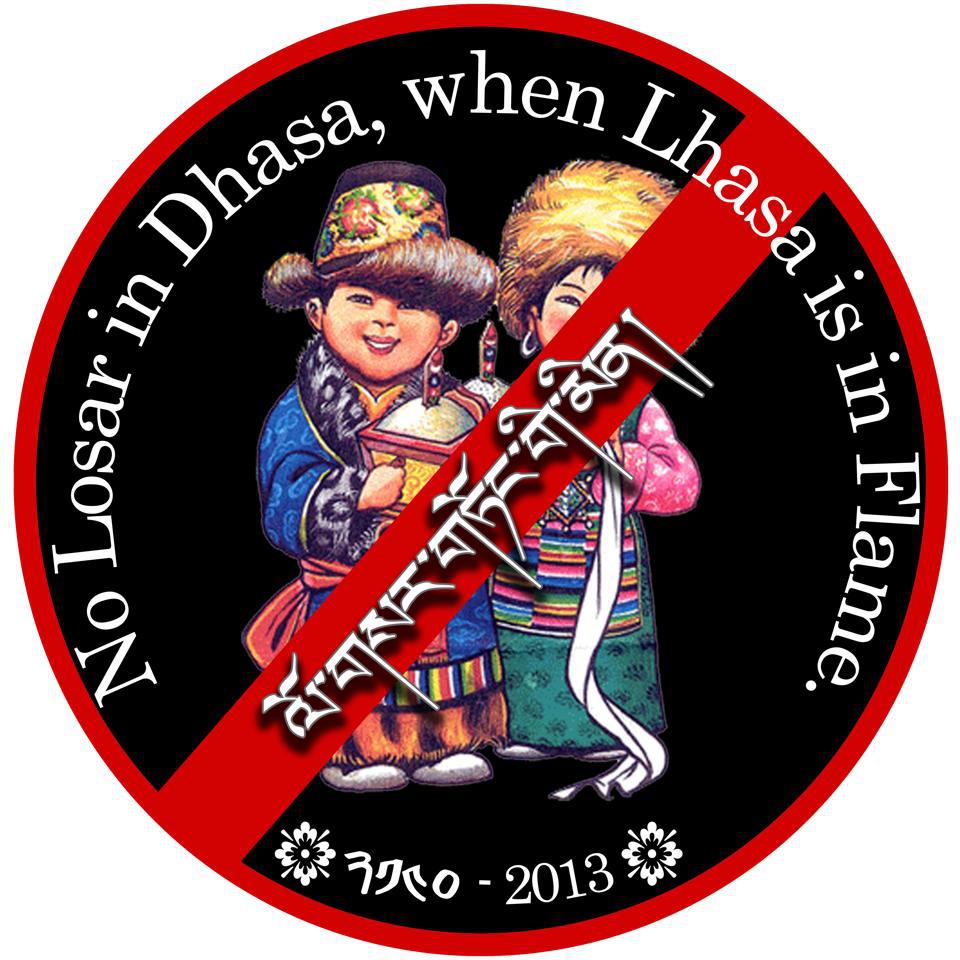High Peaks Pure Earth has translated a blogpost by Woeser written on February 10, 2013 for the Mandarin service of Radio Free Asia, as well as the Tibetan service and published on her blog on February 11, 2013.
Following on from the last translation where Woeser looked back on the year 2012, the post below turns to Losar (Tibetan New Year) and the tendency amongst Tibetans since 2009 to forego traditional celebrations. This is something that Woeser actively blogged about at the time and was also observed by High Peaks Pure Earth by monitoring blogposts.
For a news report about the vigil held by monks of Lutsang Monastery that Woeser mentions, see this piece from Radio Free Asia.

Looking Back At the Past Few Years of “Not Celebrating Losar”
By Woeser
In 2008, protests spread across the entire Tibetan region, it was “the year of the mouse and the roaring lion” (the year of the mouse refers to the Chinese lunar calendar; the roaring lion stands for Tibet). After 2008, everything changed. It seems that when there were underground movements, the surface was calm and when the surface was calm, there were underground movements; the people, the grassroots of society, resisted again and again, gradually transforming into ever increasing blazing flames.
Let us return to Losar 2009 (Tibetan New Year), many Tibetans inside and outside Tibet refused to celebrate it and instead chose to spend it in commemorative silence. At the time, in Amdo and Kham, in a privately circulated leaflet it said: “During the incidents on March 10, thousands of fellow Tibetans were arrested and sent to prison, thousands of fellow Tibetans suffered from persecution, thousands of fellow Tibetans disappeared; we Tibetans living our quiet and simple lives, if you have a conscience, if you want to live a life sharing joy and sorrows, then we ask you to do the following two things: don’t indulge in singing and enjoyment; don’t light firecrackers or fireworks. Hopefully everyone will be able to follow these two requests, helping us to commemorate the dead and pray for the living!”
Another leaflet read: “Brothers and sisters, monks and ordinary people of the three Tibetan provinces (Amdo, U-Tsang and Kham) of the same root and family, we have to unite, resist together, never ever give in to those invading our homeland. The people of the three provinces must stand together through thick and thin, never forget the fellow compatriots that have been shot dead, they did not die for their own benefits but because they fought for freedom and justice. Thus, as Tibetans, we cannot celebrate Losar…”
The local authorities firstly reacted with violence, they regarded not celebrating Losar as an act of severe “separatism” and arrested several “rumour mongers” in Lhasa who had spread messages to not celebrate Losar on the streets or online. In Dzogang County, Kham (today’s Dzogang County of TAR), a young Tibetan, Pema Tsepak, who had been shouting slogans on the street, died at the beatings of the military police on January 20. Secondly, the local authorities also forced Tibetans to celebrate Losar; for example in Rebgong, Amdo (today’s Tongren County, Qinghai Province) the local government went from house to house and distributed documents, requesting Tibetans to sign and leave their fingerprints, hereby agreeing that this year there would not happen the same resistance as last year, agreeing that they would always follow the words of the Party and the government, agreeing that they would have to celebrate a grand and prosperous Losar. In Labrang, Amdo (today’s Sangchu County, Gansu Province), Ngaba, Amdo (today’s Ngaba County, Sichuan Province) and other places, the local government gave out firecrackers to all their staff, asking them to light them during New Year. Thirdly, the official media blamed the Tibetan government in exile and the Tibetan Youth Congress for instigating this movement of not celebrating Losar inside Tibet.
As Losar was approaching, the local authorities did on the one hand try to do their utmost to maintain the false appearance of harmony and happiness; for example, Tibet TV imitated the CCTV New Year’s Eve Gala by putting together a Tibetan New Year’s Eve Show; they created the biggest, most exaggerated, most expensive and highly censored “show of empty words”. On the other hand, however, they increased the military presence, for example in the Tibetan areas of Sichuan Province, by sending in military troops from Chengdu military base, one of China’s seven largest military bases; during Losar they held a large-scale military exercise in Tawu county, northern Kham and Litang County, southern Kham as well as in Kakhok County in Amdo.
In fact, the call to not celebrate Losar had been first put forward by Tibetans from inside Tibet. What this spontaneous and unified choice by farmers, herdsmen, city dwellers, students, monks and nuns and even Tibetans working within the system showed was that the Tibetans living in the five administrative subdivisions of China were willing to stand together and that they did not serve the local authorities, they did not praise them, did not obey them.
So on the first day of Losar on February 25, 2009, over a hundred monks from Lutsang Monastery, Mangra county, Amdo (today’s Guinan County, Qinghai Province) lit candles and walked to the county government to sit quietly in front of the gate with their heads wrapped in their robes. They even took the risk and “collaborated with the separatists“ and sent photos of the scene out by email, putting forward 4 points to be heard: “1. The Chinese government should understand the aspirations of Tibetan monks and especially that of the younger generation; 2. This year’s resistance to not celebrate Losar is a lot more widespread than last year’s protests; 3. The candlelight vigil is an act of giving all Tibetans inside and outside of Tibet a New Year’s gift; 4. Wishing for the quick resolution of the ‘Tibet issue’.” Not long afterwards, thirteen monks of Lutsang Monastery were arrested and interrogated; later on, four monks were sentenced to two years in prison.
Actually, 2009 was not the only year of not celebrating Losar. Over the past few years, Tibetans all celebrated it in a way that did not correspond with the plans of the authorities. In 2013, the beginning of the Tibetan year of the Water Snake, faced with the bitterness of 104 Tibetans bathing their bodies in flames since 2009, faced with the inhuman way in which the Chinese government harmed relatives and friends of the self-immolators, framing them with all sorts of preposterous accusations that were also full of loopholes, many Tibetans decided to refuse to celebrate Losar and instead commemorated in silence, expressing their respect towards the devotees and resistance against the oppressors.
February 10, 2013





Follow Us!